Restoring a home, regaining a bit of history
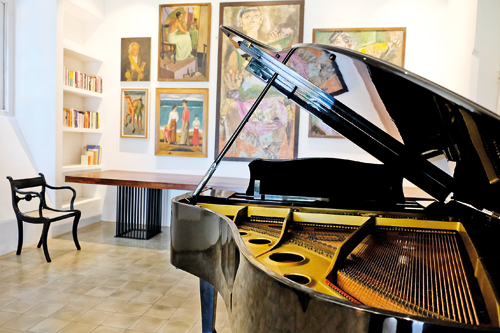
Music and art take pride of place: Druvi’s grand piano stands in one of the most interesting rooms in the house
All Amila de Mel had was one photograph and Sharmini de Saram’s memories to help her recreate a certain shade of pink. The complex colour, layered with rich undertones of mango yellow, dominates an external wall in the newly renovated De Saram House in Colombo 7. It was inspired by Druvi de Saram’s love of Tuscan architecture.
Amila knows all this thanks to long, meandering WhatsApp conversations with Sharmini, Druvi’s wife. It allowed them to recreate in painstaking detail the home that first underwent extensive renovations under Geoffrey Bawa in 1986.
The legendary architect originally combined two small houses on Ward Place into a space the couple could share with their daughters Radhika and Mandhira. Though they were initially still too young to occupy them, the girls would get their own bedrooms, complete with interconnected upper levels.
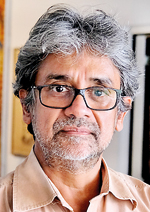
Channa Daswatte, Trustee of the Bawa Trust
The very subtle additions in the recent round of renovations only serve to emphasize everything Bawa himself did, such as raise the roofs, add new rooms and create connecting corridors and courtyards. “He built this home around the trees in the garden,” says Amila, estimating that one particularly grand old Jak is a century old.
When Bawa first started work on the De Saram House, Amila had not yet joined his practice. When she did become a part of his team in the early ’90s, Bawa had moved on to renovating the home in front of Druvi’s, which belonged to his mother, another one of the many projects the architect undertook for members of this family.
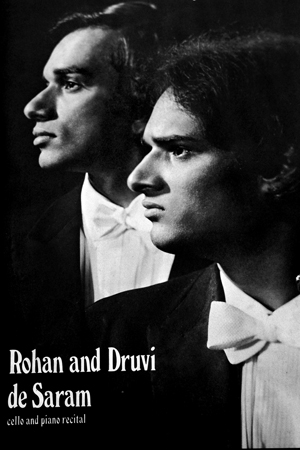
The famed classical musician brothers, Rohan and Druvi de Saram
By then, it was very evident that the de Sarams were more than clients – they were the closest of friends. Druvi is a gentle soul and Bawa could count on Sharmini feeding him a delicious meal. Many evenings found the architect ambling into their home, certain of his welcome.
Though they were much younger than Bawa, there was a never a lack of conversation. Sharmini once said that the hours spent with Bawa designing this house were among the happiest of their lives. When the family left for London, where they now live, Bawa was visibly bereft.
In the next 25 years, the De Saram home saw a series of rentals. “Over time, it lost its soul somehow. It did not have quite that original sparkle,” says Amila, who was hired by the family 18 months ago to restore it to its original splendour and prepare it for a new phase in which it is to be managed by the Bawa Trust.
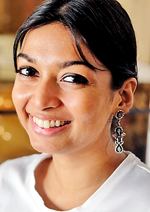
Shayari de Silva, Curator of the Bawa Trust
Noting that the building is in the heart of Colombo, Channa Daswatte, architect and Trustee of the Bawa Trust says that its debut is a special moment in the year which will mark the centenary of Bawa’s birth. The property will join Lunuganga, No.11 and Ena’s House as spaces open to guests for pre-booked tours and overnight stays, offering a rare opportunity to live in a building designed by a man now celebrated as one of the greats of Sri Lankan architecture. For the Trust, this is about a sustainable way of preserving Bawa’s legacy.
Watching Amila return the space to life has been a pleasure, highlighting as it does Bawa’s adept use of shared spaces to link moments of quiet and intimacy. The architect’s framing ensures that the house opens up again and again, in an origami-like arrangement of juxtaposing views and lines of sight that stretch from bedrooms to verandahs and into the garden beyond.
Throughout, Channa finds himself once more admiring how Bawa was so much of this place. “In his buildings, there is this wonderful magic of never being far away from a view of the world outside. Nowhere in a Bawa building are you looking at a blank wall…be it a courtyard, be it a view through a window, everywhere you turn, you are constantly aware of the beauty of the landscape in which you are, of the richness and fecundity of Sri Lanka.”
 Setting the De Saram House truly apart is one of the finest private collections of art on the island, replete with notables from the `43 Group. Among them are a large number of works by Justin Daraniyagala, who was Druvi’s uncle. They are beautifully displayed in what is one of the most interesting rooms in the house.
Setting the De Saram House truly apart is one of the finest private collections of art on the island, replete with notables from the `43 Group. Among them are a large number of works by Justin Daraniyagala, who was Druvi’s uncle. They are beautifully displayed in what is one of the most interesting rooms in the house.
Druvi is famous as one of the most talented pianists the island has ever produced, and the floor is dominated by his grand piano. (This family boasts more than its fair share of musical prodigies, counting among its ranks Druvi’s brother, the acclaimed cellist Rohan de Saram and his daughter Mandhira, who is a violinist and founding member the Ligeti Quartet).There were two Directors of Archaeology in the Deraniyagala family, and a small yet notable collection of masks occupies several shelves. However, the walls belong to the paintings.
As you enter on your right, Justin’s Nedra, Fruit Seller, and Musician are among five originals in this room alone. Hanging alongside his stunning work is Family on Beach, an early oil on canvas by Ivan Peries, Boy with Bull by Richard Gabriel (this from the Geoffrey Bawa Collection) and a fine portrait of Christoffel Henricus de Saram, 4th Mahamudaliyar of the Governor’s Gate (1755 – 1841).
Shayari de Silva, the young curator of the Bawa Trust has a particular fondness for the last – she sees Druvi’s features echoed in that of his ancestor. “He was Druvi’s great, great, great grandfather. There he is in his uniform, and Druvi is the spitting image of him.” She hopes Christoffel will preside over the series of soirees and musical events the Trust hopes to stage here.
As she walks through the house,Shayari points to a George Keyt that was signed to Druvi, a beautiful series of nudes and sketches by Laki Senanayake and drawings and fabric hangings by Barbara Sansoni. For her, the fact that so many painters of the ’43 Group are represented here is particularly noteworthy. Widely hailed as a catalyzing force behind the development of 20th century Sri Lankan Art, the group included such luminaries as Lionel Wendt, Harry Pieris, George Keyt, Ivan Peries, Aubrey Collette and Justin himself.
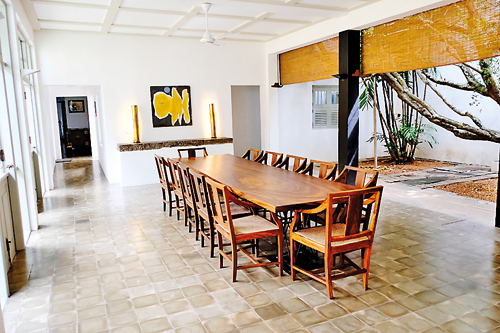
Open dining space
“What is remarkable about the house is how it brings several art forms together,” says Shayari, adding,“here, as with so many of the spaces designed by Bawa, the arts are enjoyed across disciplines, rather than in isolation. I suppose this was the case even with the ‘43 Group, where painting, photography and music were all used as mediums of expression – which makes it very fitting that the music room at the de Saram house shows a capsule collection of many of the key players from the Group!”
In the end, Channa believes that in this way, the home will offer visitors an entirely unique experience. “We want people to understand how these connections underpinned post-independence artistic history, and how they made Sri Lankan modernism possible,” says Channa. “In that sense, this is more than a house, it is more than a boutique hotel. It’s a little lesson in history.”
| Geoffrey Bawa centenary programme | |
| 2019 marks the centenary of Geoffrey Bawa’s birth and the Geoffrey Bawa and Lunuganga Trusts will celebrate this eminent architect’s legacy through a programme of events scheduled from July 2019 to July 2020. The extensive programme will inspire and initiate work that spans geographic, generational and medium-specific divides, using the ideal contextual background of Geoffrey Bawa’s life and work. The public programme will be launched in July with the exhibition “Decorative Arts in the Geoffrey Bawa Collection” held at Lunuganga from July 13-21. On July 22, the 5th cycle of the triennial Geoffrey Bawa Awards will be launched, to be followed by the 16th Annual Memorial Lecture on July 23, which marks Geoffrey Bawa’s 100th birthday. The lecture will be held at the Sri Lanka Foundation Institute and will be delivered this year by well known Japanese architect Kengo Kuma. The lecture will coincide with “Unknown Bawa”, an exhibition of photographs by Sebastian Posingis at Paradise Road, The Gallery Café from July 23-31. The launch of “The Gift,” a series of site-specific installations at Lunuganga, will follow, featuring work by eminent architect Kengo Kuma (Japan) and artists Lee Mingwei (New York and Paris), Dominic Sansoni (Sri Lanka), Dayanita Singh (India) , Sarah Sze (New York) and Chandragupta Thenuwara (Sri Lanka). The launch will feature a panel discussion with the participating artists at the Barefoot Gallery on July 24, to be followed by the opening of Dayanita Singh’s exhibition “Bawa – Box 507,” also at Barefoot. The exciting public programme of exhibitions, events, talks and tours will continue throughout the year; for the full programme see www.bawa100.com.
|
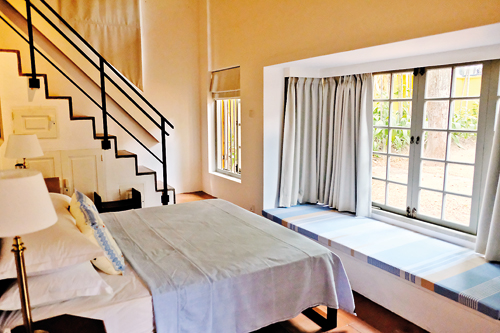
A room with a view in the heart of Colombo


